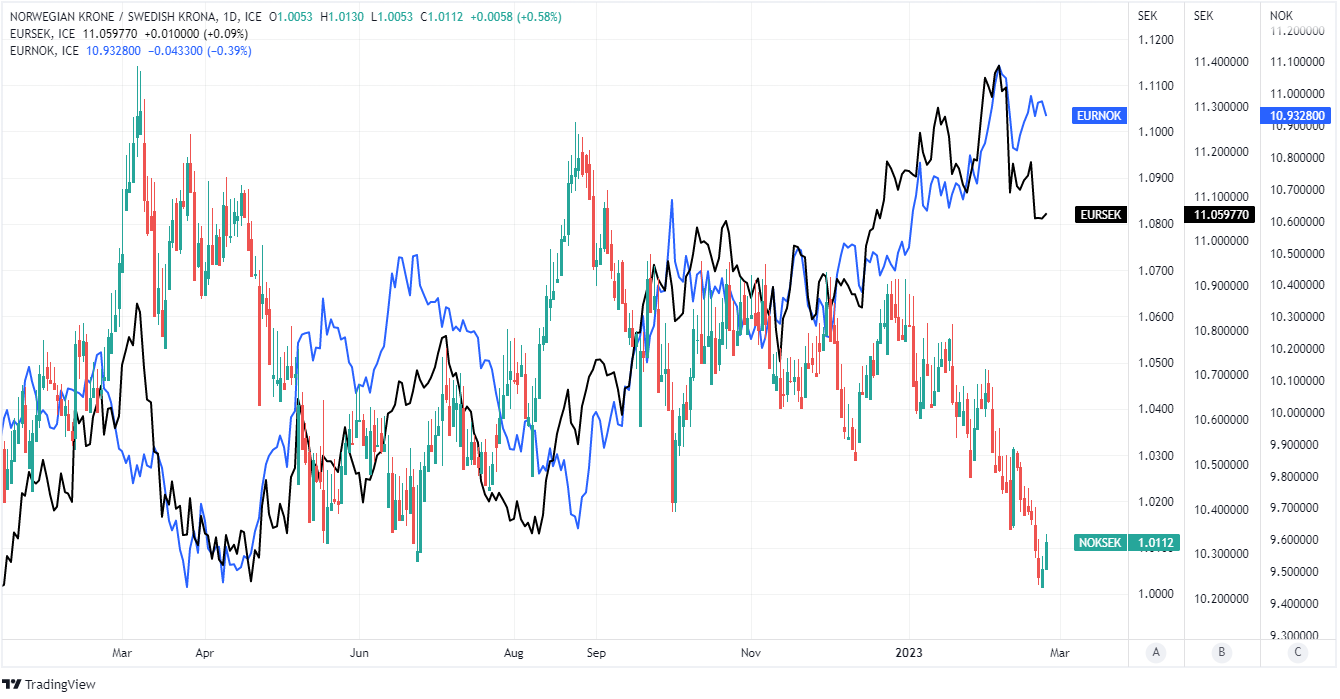Sell Swedish Krona for Norwegian Krone to Trade Inflation Says TS Lombard
"Norway deals with many of the same problems as Sweden – an economy vulnerable to rising rates and a weaker currency, especially vs the Euro putting upwards pressure on inflation. However, the Norges Bank has more room to manoeuvre with slightly less inflationary pressure and growth surprising" - TS Lombard.

Image © Adobe Images
The Swedish Krona has outperformed notably in 2023 but was this week tipped as a sell by strategists at TS Lombard, who've advocated that clients buy the Norwegian Krone with the proceeds due to differences between inflation rates and risks embedded in the respective economies.
Sweden's Krona was not the best performer in the G10 bucket on Thursday but it was a long way from being the worst and still retained large gains in relation to many counterparts for the recent week, month and year of 2023 overall.
The Scandinavian currency's rally began when the Riksbank raised its cash rate to 3% earlier in February and said the benchmark would be likely reach 3.33% later this year, although its outperformance has extended since last week's publcation of inflation figures for January.
"Inflation hasn’t peaked everywhere. How quickly it falls and where it settles continues to be a major market driver. US inflation is seemingly leading the way, having peaked in the summer and since then followed a fairly clear trajectory downwards," says Skylar Montgomery Koning, a strategist at TS Lombard.
"But in the Scandi and antipodean economies inflation remains persistent or has reaccelerated. This is a stark reminder to investors that the global inflation problem has not gone away: inflation can always reaccelerate," Koning and colleagues write in a Wednesday research briefing.
 Above: NOK/SEK shown at daily intervals alongside EUR/SEK and EUR/NOK. Click image for closer inspection. To optimise the timing of international payments you could consider setting a free FX rate alert here.
Above: NOK/SEK shown at daily intervals alongside EUR/SEK and EUR/NOK. Click image for closer inspection. To optimise the timing of international payments you could consider setting a free FX rate alert here.
Inflation rose from 11.5% to 12.3% in January, Statistics Sweden said last Monday, implying a risk of it exceeding a Riksbank forecast for 2023 that was downgraded from 9.3% to 8.6% earlier this month.
This has prompted interest rate derivative markets to price-in a higher expected peak of around 3.8% for the cash rate at a point when the economy is already slowing and house prices have already begun to fall from inflated levels, risking negative 'wealth effects' that could hasten the economic slowdown.
"Like many of the high-beta economies, Sweden has a large amount of debt and the Swedish housing market is acutely vulnerable to rising interest rates; house prices are already down significantly. Recession odds are the second highest in G10 (after GBP) and 4Q GDP was in contraction," Koning says.
"As hikes feed into a slowing Swedish economy, the growth outlook will eventually outweigh the hawkish impact on the currency. Moreover, it raises the risk of a policy mistake that would see the currency sharply lower (à la UK). SEK is cheap for a reason," she adds.
Meanwhile, elsewhere, the Norwegian economy faces many of the same challenges but without the same number of vulnerabilities.
 Above: NOK/SEK shown at weekly intervals alongside EUR/SEK and EUR/NOK. Click image for closer inspection. (If you are looking to protect or boost your international payment budget you could consider securing today's rate for use in the future, or set an order for your ideal rate when it is achieved, more information can be found here.)
Above: NOK/SEK shown at weekly intervals alongside EUR/SEK and EUR/NOK. Click image for closer inspection. (If you are looking to protect or boost your international payment budget you could consider securing today's rate for use in the future, or set an order for your ideal rate when it is achieved, more information can be found here.)
"Norway deals with many of the same problems as Sweden – an economy vulnerable to rising rates and a weaker currency, especially vs the Euro putting upwards pressure on inflation. However, the Norges Bank has more room to manoeuvre with slightly less inflationary pressure and growth surprising above the central bank’s forecast. With inflation reaccelerating, it is likely they will raise the policy rate above 3%," Koning says.
"We buy NOK/SEK. NOK and SEK are both undervalued on a real effective exchange-rate basis, but the NOK/SEK cross recently reached a one- year low, as it approaches parity on expected Riksbank hawkish. But we expect the Norges Bank to continue to tighten at a hawkish meeting next month – and this has yet to be reflected in the currency. Moreover, Norway’s growth prospects for 2023 are much better than those of Sweden," she adds.
The Norges Bank raised its cash rate to 2.75% in January but warned that an ongoing slowdown of the economy "may suggest a more gradual approach to policy rate setting," over the coming months, meaning there may be a risk of it leaving borrowing costs unchanged in its next decision on March 23.
However, since then, Statistics Norway has released figures suggesting that inflation rose from 5.9% to 7% in January, ahead of the consensus expectation among economists for a lesser increase to 6.5% and opening the door for it to follow in the footsteps of the Riksbank next month.
To the extent that it does, this could mean a repeat of the outperformance enjoyed by the Swedish Krona but on the other side of the NOK/SEK equation, which is why Koning and colleagues have tipped the pair as a buy this week.